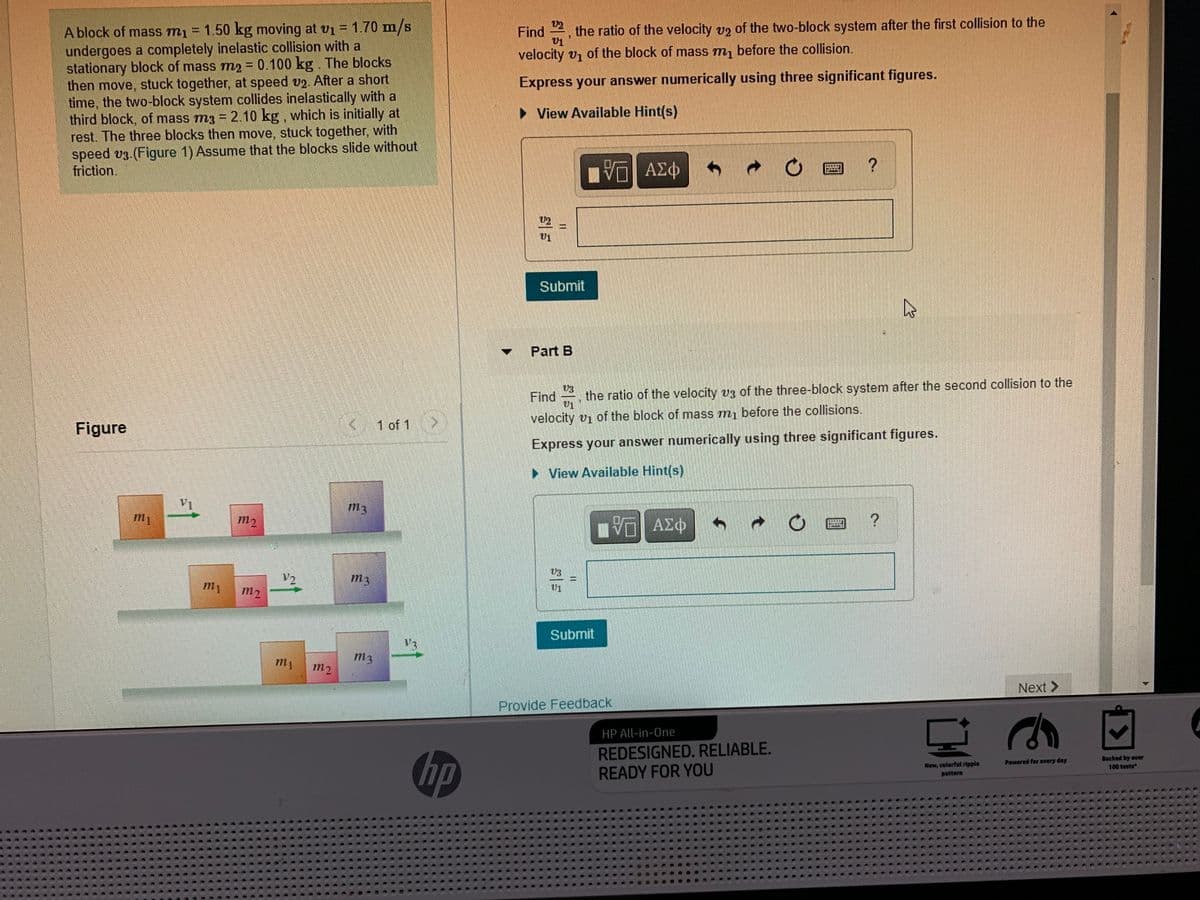A block of mass m = 1.50 kg moving at vi = 1.70 m/s undergoes a completely inelastic collision with a stationary block of mass m2 = 0.100 kg. The blocks then move, stuck together, at speed v2. After a short time, the two-block system collides inelastically with a third block, of mass m3 = 2.10 kg, which is initially at rest. The three blocks then move, stuck together, with speed v3 (Figure 1) Assume that the blocks slide without friction. Find the ratio of the velocity vy of the two-block system after the first collision to the velocity v, of the block of mass m, before the collision. Express your answer numerically using three significant figures. • View Available Hint(s) ? %3D Submit Part B Find the ratio of the velocity vz of the three-block system after the second collision to the Figure < 1 of 1 velocity vi of the block of mass m, before the collisions. Express your answer numerically using three significant figures.
A block of mass m = 1.50 kg moving at vi = 1.70 m/s undergoes a completely inelastic collision with a stationary block of mass m2 = 0.100 kg. The blocks then move, stuck together, at speed v2. After a short time, the two-block system collides inelastically with a third block, of mass m3 = 2.10 kg, which is initially at rest. The three blocks then move, stuck together, with speed v3 (Figure 1) Assume that the blocks slide without friction. Find the ratio of the velocity vy of the two-block system after the first collision to the velocity v, of the block of mass m, before the collision. Express your answer numerically using three significant figures. • View Available Hint(s) ? %3D Submit Part B Find the ratio of the velocity vz of the three-block system after the second collision to the Figure < 1 of 1 velocity vi of the block of mass m, before the collisions. Express your answer numerically using three significant figures.
College Physics
11th Edition
ISBN:9781305952300
Author:Raymond A. Serway, Chris Vuille
Publisher:Raymond A. Serway, Chris Vuille
Chapter6: Momentum, Impulse, And Collisions
Section: Chapter Questions
Problem 45P: A tennis ball of mass 57.0 g is held just above a basketball of mass 590 g. With their centers...
Related questions
Topic Video
Question

Transcribed Image Text:A block of mass m1 = 1.50 kg moving at vi = 1.70 m/s
undergoes a completely inelastic collision with a
stationary block of mass m2 = 0.100 kg . The blocks
then move, stuck together, at speed v2. After a short
time, the two-block system collides inelastically with a
third block, of mass m3 = 2.10 kg, which is initially at
rest. The three blocks then move, stuck together, with
speed v3.(Figure 1) Assume that the blocks slide without
friction.
Find , the ratio of the velocity v2 of the two-block system after the first collision to the
velocity v of the block of mass m, before the collision.
Express your answer numerically using three significant figures.
• View Available Hint(s)
Or
ΑΣΦ
U1
Submit
• Part B
U3
Find
the ratio of the velocity v3 of the three-block system after the second collision to the
K1 of 1
velocity v1 of the block of mass m, before the collisions.
Figure
Express your answer numerically using three significant figures.
> View Available Hint(s)
V1
m3
m2
V2
m2
m3
m1
Submit
m3
m1
Next >
Provide Feedback
HP All-in-One
hp
REDESIGNED. RELIABLE.
READY FOR YOU
Backed by over
100 tests*
Powered for every day
New, colorful ripple
pattern
Expert Solution
This question has been solved!
Explore an expertly crafted, step-by-step solution for a thorough understanding of key concepts.
This is a popular solution!
Trending now
This is a popular solution!
Step by step
Solved in 4 steps

Knowledge Booster
Learn more about
Need a deep-dive on the concept behind this application? Look no further. Learn more about this topic, physics and related others by exploring similar questions and additional content below.Recommended textbooks for you

College Physics
Physics
ISBN:
9781305952300
Author:
Raymond A. Serway, Chris Vuille
Publisher:
Cengage Learning

Principles of Physics: A Calculus-Based Text
Physics
ISBN:
9781133104261
Author:
Raymond A. Serway, John W. Jewett
Publisher:
Cengage Learning

University Physics Volume 1
Physics
ISBN:
9781938168277
Author:
William Moebs, Samuel J. Ling, Jeff Sanny
Publisher:
OpenStax - Rice University

College Physics
Physics
ISBN:
9781305952300
Author:
Raymond A. Serway, Chris Vuille
Publisher:
Cengage Learning

Principles of Physics: A Calculus-Based Text
Physics
ISBN:
9781133104261
Author:
Raymond A. Serway, John W. Jewett
Publisher:
Cengage Learning

University Physics Volume 1
Physics
ISBN:
9781938168277
Author:
William Moebs, Samuel J. Ling, Jeff Sanny
Publisher:
OpenStax - Rice University

Physics for Scientists and Engineers: Foundations…
Physics
ISBN:
9781133939146
Author:
Katz, Debora M.
Publisher:
Cengage Learning

Physics for Scientists and Engineers with Modern …
Physics
ISBN:
9781337553292
Author:
Raymond A. Serway, John W. Jewett
Publisher:
Cengage Learning

Physics for Scientists and Engineers, Technology …
Physics
ISBN:
9781305116399
Author:
Raymond A. Serway, John W. Jewett
Publisher:
Cengage Learning